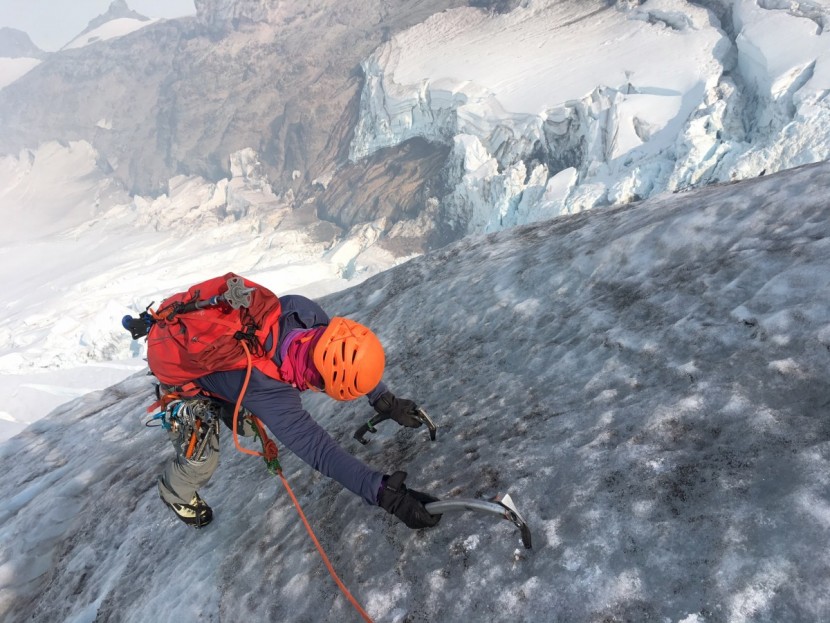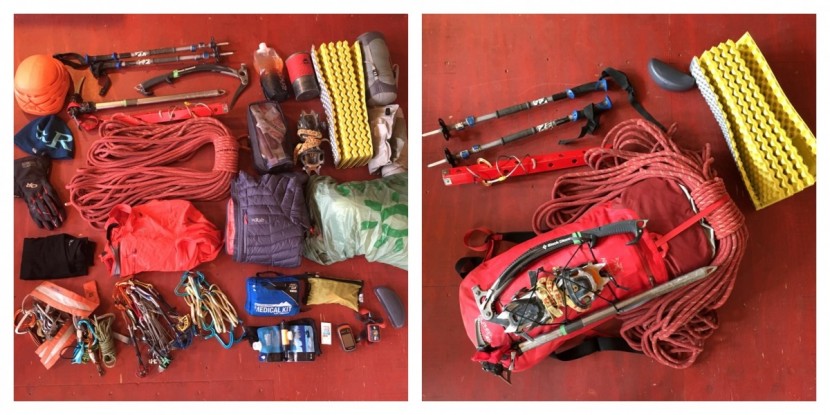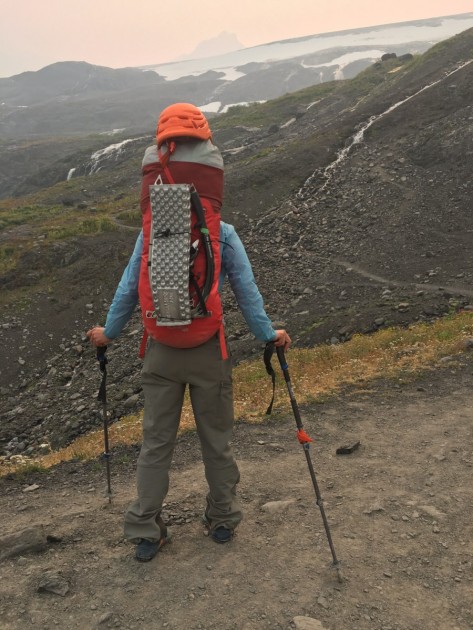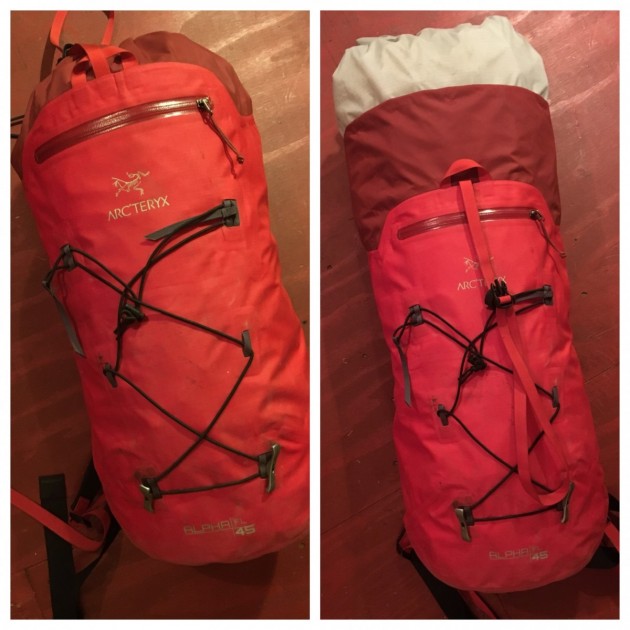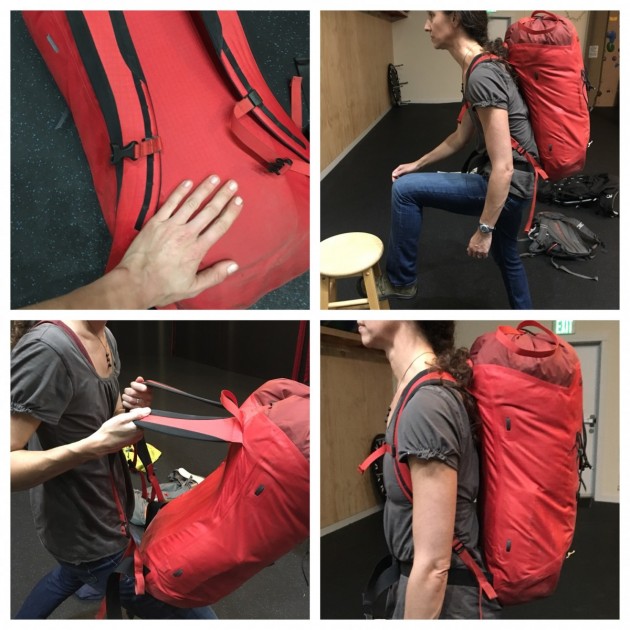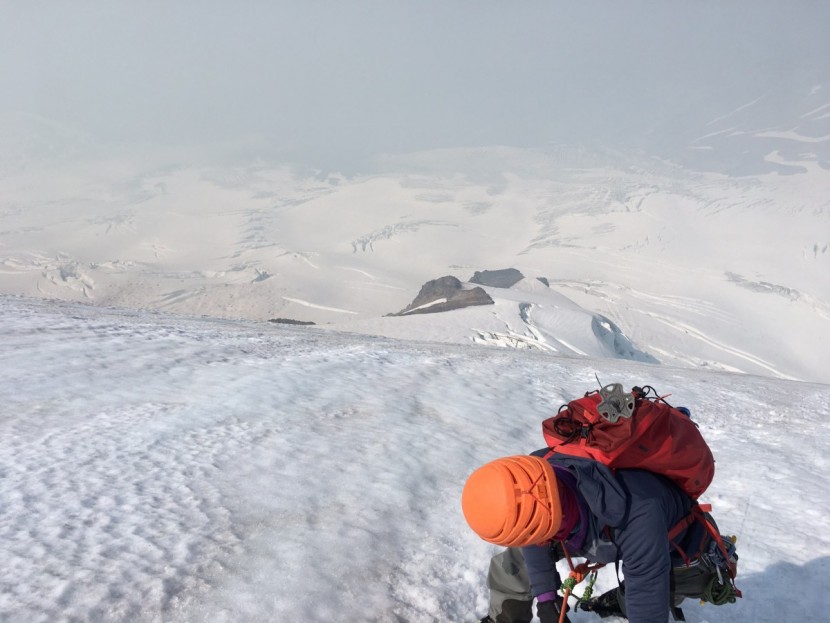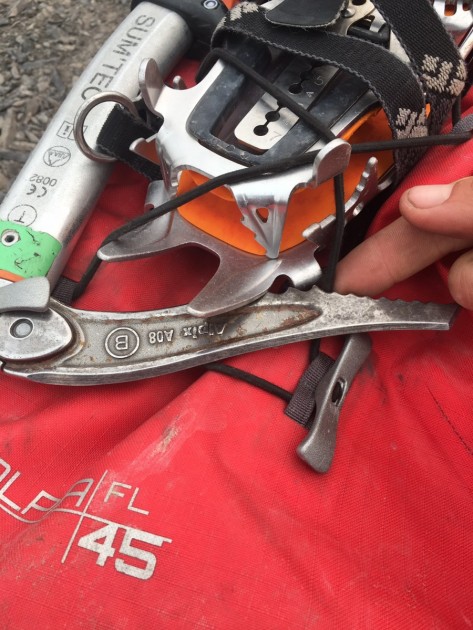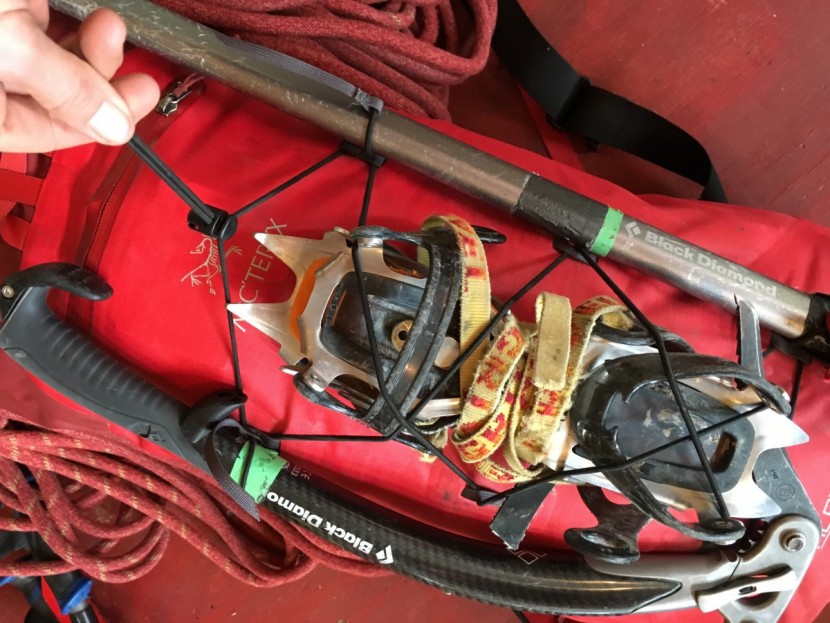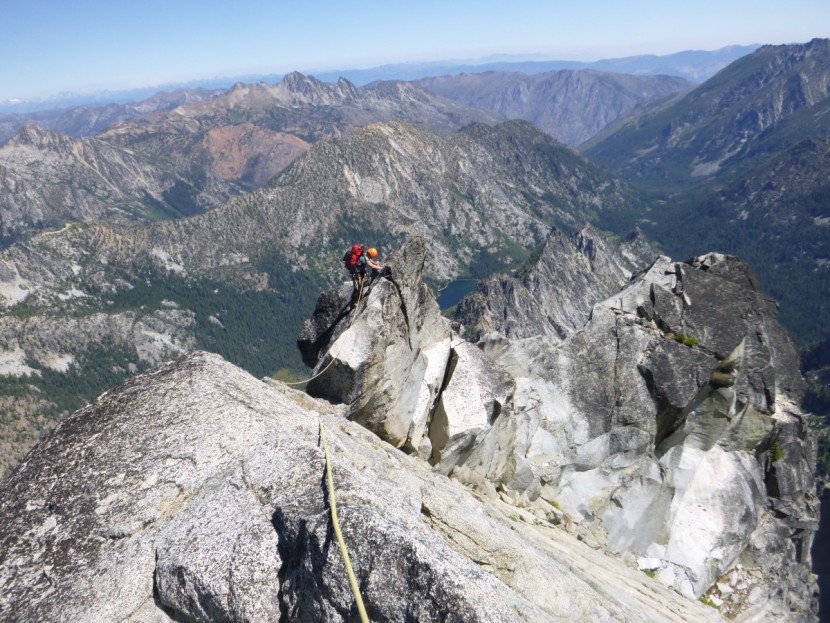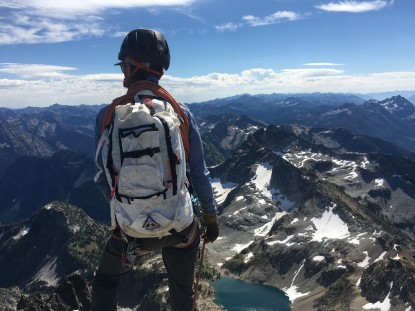Arc'teryx Alpha FL 45 Review
Our Verdict
Our Analysis and Test Results
Weight-To-Volume Ratio
The Alpha FL is best considered a 30-liter pack that can be overstuffed up to about 45 liters for a relatively brief haul to basecamp. The pack proved ideal, in particular, for a climb on the North Ridge of Mt. Baker late in the summer when it was a long and technical ice climb.
We left the cars at 3 am, dropped overnight gear at basecamp after an hour and a half of hiking, then continued to our objective. We returned later in the day and spent the night so that we could practice crevasse rescue skills—two of the three of us were preparing for an upcoming American Mountain Guides Association Alpine Exam. This, we decided, was the perfect application for this pack.
No matter how you do the math, whether counting this as a 30 or 45-liter pack, it comes out with the best weight to volume ratio in the review. This does not come at a cost to features, but many of our testers spend a whole lot of time with packs on their back. As time goes on, and we all get a little older, we have grown to appreciate simple, lightweight gear—it may cost more and wear out sooner (sometimes), but ultimately we save on physical therapy bills. No joke.
The extendable collar tucks into the body of the pack when not using it, and we found this got in the way sometimes, but it was a tradeoff because it also made the pack more straightforward to get in and out of while on the climb (just a single-hand pull of the drawcord closure). There were a few drawbacks to this pack, which we will touch on in the next metrics; however, very negative was at least partially mitigated by the Alpha's phenomenal light weight. And that goes a long way.
The Black Diamond Blitz 28 would seem to be a very similar pack, useful in roughly the same circumstances. However, we found that the Blitz had a lower profile for use on routes, giving it a slight edge over the Alpha for our favorite on-route climbing pack.
Comfort
This model tied for the highest comfort score in this review with the Osprey Mutant. Neither are perfect, but both were excellent in slightly different ways.
Arc'teryx uses a ridiculously simple design for this pack which we assumed, on first inspection, would greatly reduce its comfort in exchange for its light weight. It turned out both went together, ensuring that the Alpha remained comfortable.
The back panel is a stiff but flexible material that formed readily to our back yet still protected us from the contents poking us. It hugged our backs and moved with us on every high step and tool swing. The hip belt is a simple, piece of webbing, completely unpadded; at first, this seemed ridiculous. But it meant that the hip belt sat comfortably above our harness and entirely out of the way, securing the pack to our torso without feeling cumbersome. The Alpha also did not feel uncomfortable on the approach, as we would have expected.
The pack does not have load lifter straps on top of the shoulder straps to bring the pack in closer to the back. We see this more and more in lightweight models, and it continues to blow our minds. Perhaps this is why we review such items, instead of engineer them. However, if it works, it works. We did find that the load-lifter-less strap design was even more, comfortable in the Hyperlite Mountain Gear 3400 Ice Pack, but we were still impressed with Arc'teryx.
Our physical therapist loved this backpack. The flexible back panel allowed us to flex our spine, which is crucial for long climbs. Extension is the opposite of flexion. It is where your chest is thrust forward, shoulders back, and is a very powerful posture that we will regularly use throughout a technical climb; however, you don't want a backpack to lock you into that position—and those with aggressive lumbar support and shaped back panels often do just that. Flexion, where you curl a little bit forward (like when you're doing crunches), allows you to fully exhale and relax—a necessary and restful position for the times when you don't need so much strength and power.
Over the past decade, we have seen an increasing amount of simple mountaineering backpacks with less and less “support.” Climbers have picked up this concept intuitively. For those who get out into the mountains frequently and have a high level of strength and a healthy, balanced musculature, this straight-backed, simple, flexible pack design has proven preferable for many. And as irony would have it, this freedom of movement also allows climbers to move more naturally, enhancing endurance through proper rest and recovery. So if you can build up the necessary postural strength over time, focusing on a gentle progression which strengthens all those easily-overlooked supportive muscles, then a pack like this can work for you—and if this ultralight pack can work for you, chances are you'll feel less tweaked after lugging your climbing kit around the mountains. Remember, however, that it is worth it to complete your kit of climbing gear with similarly lightweight equipment, wherever you can.
Last but not least in this category, the Alpha is shaped to climb. It has a tapered design, narrower at the bottom and wider at the top. This helps make it easier to get your gear in and makes it better for climbing movement, but it can be trickier to pack perfectly. This pack challenged our packing prowess, but when we got it dialed, we couldn't have been happier.
For a similarly comfortable pack with a little more versatility, we also really like the Patagonia Ascensionist. It is almost as simple as the Alpha, and almost as light, but it adds a few features like side straps and adjustable lightweight hip padding which make it much more versatile.
Durability
This pack didn't top our charts for durability, only because of the thin fabric used in the extendable collar and the relatively thin shock cord used for the ice tool and crampon attachments (which never gave us issue, but we were sure to be careful with it).
That said, it still scored above average.
This pack impressed us much more than the Hyperlite Mountain Gear 3400 Ice Pack, which has numerous holes in it after one trip on the Torment-Forbidden Traverse in Washington's North Cascades. We tried to scratch and scuff this pack, put sharp objects inside like our pickets (because there are no side straps for them, more on that later)—but we did not manage to put a single hole in the Alpha FL. Otherwise, this pack is just so simple that there is little to fail, which is worth a significant amount in the durability department.
Versatility
This metric, along with the features below, were the lowest scores for the Alpha FL, but not the lowest overall. It still gets a “passing” score, but we found the versatility to be a weaker point. The durable fabric can withstand your freshly-tuned ski edges, though you'll have to rig a carrying system yourself. The Alpha FL has lash points—four on each side—that allow climbers to strap gear on using cord or 3/4" webbing.
The lack of side straps made this pack more of a specific-use model. For example, this is not the most natural pack to use for a trek to base camp where you drop your gear and then climb your objective. Why? If you attach ice tools, then there is nowhere left to put a picket or trekking pole(s). It is particularly challenging to figure out where to put a foam sleeping pad.
As such, this pack is optimized for the fast-and-light missions where you're either climbing in a day or bumping camp every night, such as on a high alpine traverse. In this case, you'll likely cut weight and leave a foam pad behind, relying instead on an ultralight and compact, inflatable pad. This is the perfect pack for technical alpine missions with a very lightweight climbing kit.
For a few more features and a much more versatile pack, we loved the Patagonia Ascensionist. The gain in versatility comes at minimal cost to weight, making it edge ahead of the Alpha overall.
Features
Simple would be an understatement. This category is also the lowest scoring category for this pack, but still not the lowest score in the review. The few features it does have are very well thought-out.
For example, both the Alpha FL and the Hyperlite 3400 Ice Pack have a single zipper pocket. On the Alpha, it is external, waterproof, and relatively easy to access (though a bit tricky when the pack is overstuffed). Hyperlite put a similarly sized pocket on the inside where it quickly becomes buried in gear and puffy jackets. Patagonia got this right with its zippered pocket on the top of the pack on the Ascensionist pack.
The elastic shock cord that secures ice tools, crampons, or whatever else you want to be easily accessed, is also very simple and extraordinarily easy to use. It has a tensioning system that is both intuitive and secure. The only drawback is that the pack is so light and flexible that when it is empty, any metal attached to the outside can flop around and feel less secure. But a puffy jacket and snacks in the main pack are often enough to resolve that issue.
We liked that we could keep the extendable collar inside the pack when not extending the pack for overstuffing, again unlike the Hyperlite Ice Pack. This made the Alpha much easier to get in and out of—we didn't have to burrow into the pack to get out snacks and water, like we did to get to the bottom of the Hyperlite pack, diving through the impossibly tall roll-top closure. When hanging out at ice belay anchors, this was by far our favorite pack. It is so light and manageable that we could clip it to the anchor in front of us, open it with one tug from gloved (or mitten-laden) hands because of the simple drawcord open/closure, and rifle through the contents.
The only drawback to this cinching closure system and the fact that the roll-top closure can stow inside the pack is that when not using that roll-top closure, the contents are more susceptible to getting wet. If this is a deal breaker for you, consider the Osprey Mutant 38.
Best Applications
The ideal trip for this pack is one we took it on: climbing the North Ridge of Mt. Baker in a day. It was late season conditions, and we were a team of three mountain guides, two of which were training for an upcoming Alpine Guide Exam. We intended to stay at base camp, so we could practice some advanced crevasse rescue drills the next morning before heading out for coffee and pastries at the local bakery. We hiked in at 3 am, dropping our bivy gear at camp at 4:30 am and continued to climb the route. We could also have done this as a 2-3 day climb in a similar fashion. This is an excellent alpine climbing pack for someone with an extremely light kit of climbing and bivy gear, and for shorter, faster missions involving complex and athletic alpine climbing.
Value
Arc'teryx is not known to be cheap, but it is also not known to be cheap. That is to say, you get what you pay for with the pricier Alpha FL. We think it is well worth the cost. We love that such a high end and lightweight alpine climbing pack is also tremendously durable. This pack will last for many, many climbs.
Conclusion
We loved the Alpha FL 45. This is somewhat specific to light and fast missions, and those climbers with extremely lightweight and compact gear. But the more time we spend in the mountains, the more we value light weight and freedom of movement. This pack nails it on both those accords.



